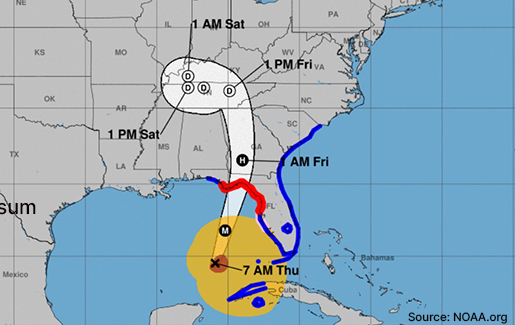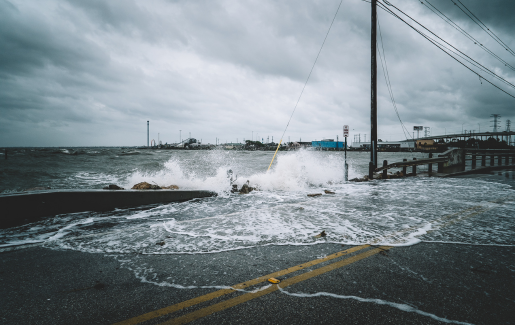
Hurricane season typically lasts from June 1 through November 30 in the United States, a potentially terrifying time of year because it's difficult to predict how often and how hard—not to mention where—the storms will hit.
The initial impact is terrifying, but as with any natural disaster, hurricanes can also leave a lengthy recovery process in their wake. There will likely be flooding, damage caused by felled trees and significant power outages—that last part potentially the most difficult to deal with given the long-term interruption of everyday life and business operations.
Mike Semel, president and chief compliance officer of Semel Consulting and longtime CompTIA Community member, shared some valuable tips and resources that can help businesses better prepare for a hurricane.
Today, hurricane preparedness doesn’t have to mean raiding stores, thanks to online shopping and overnight deliveries—if you're proactive. Here's a range of products that can prove essential in the wake of the storm and are available to quickly ship from Amazon or other sources. These include:
- Emergency radios
- Batteries
- Lanterns
- Solar chargers
- Candles
- Water jugs
- Water filters
- Food supplies
Further, Semel has long kept a well-researched preparedness plan. There’s a lot to consider before a storm hits and this list can help you fully prepare in advance:
Family and business communications plan
- Write down critical mobile and landline numbers in case your phone dies.
- Identify a place to meet family members and/or business colleagues if phone/internet communications are disrupted.
- Designate an out-of-area relative or colleague to contact if you can’t reach each others.
- Compile a contact sheet of all employees and customers, including personal e-mail addresses, spouse and partner contact information, and out-of-area contacts if you can’t reach specific employees.
Water
- Buy cases of water or fill pots and pitchers with drinking water. Estimate one gallon per day per person.
- Store 10 gallons of clean water for cooking.
- Use food-grade water containers from camping stores.
- Replace stores of water every six months if it's not commercially bottled water.
- Never use water from toilet flush tanks or bowls, radiators, waterbeds or swimming pools and spas.
- Purchase water purifiers to filter contaminated water.
Food
- Store non-perishable food that doesn't need to be cooked.
- Include food items needed for special diets.
- Store non-perishable food for pets.
Utilities
- Know how to turn off power, water and gas services.
- Keep tools near utility shutoffs for quick action.
- Never turn utilities back on until authorized by officials.
- Have a professional technician turn your gas back on.
Cash
- Withdraw several hundred dollars in small bills for cash purchases, as credit cards won’t work without power and communications.
Automobiles
- Fill gas tanks when you first hear a warning.
- Don’t drain car batteries charging cell phones or other devices.
- Keep an emergency kit in cars in case you are stranded away from home.
Cell phones
- Register your cell phone to receive calls from your county’s emergency management system.
- Install weather and disaster preparedness apps and configure for alert notifications.
- Use text messages, which use less battery and get through when calls can’t.
- Photograph the contents of your house or business.
- Store emergency contact info for family members and employees, including alternate e-mail contacts and phone numbers for their close friends and relatives in case you can’t reach them directly.
- Charge your phone(s) and keep it fully charged if possible.
- Pack car chargers and home chargers if forced to evacuate.
- Extend batteries by turning off wi-fi and other services when not in use.
- Use solar chargers when possible.
- Set up a personal internet hotspot.
Computers
- Back up critical data onto external hard drives or the cloud.
- If you have to evacuate, take critical equipment with you or seal it in garbage bags and store it in a high spot to protect against water damage.
- Pack laptop charger if you evacuate.
- Do a test-restore of your backup files to ensure that backups will work during an emergency, and that all critical data is backed up.
Generators
- Use gasoline or propane generators. Communities may turn off natural gas service prior to a disaster.
- Plan for having to provide power for air conditioning/heat, refrigerators, lights and television for seven days.
- Store gasoline in safe containers with fuel stabilizer. Replace stored gas every six to 10 months. Generators can use seven to 10 gallons of gasoline per day.
- Buy a siphon to borrow fuel for a generator from cars and mowers.
Evacuation
- Have a backpack or overnight bag pre-packed with clothes; energy and meal replacement bars; emergency blankets; sanitation and hygiene items; photocopies of identification and credit cards; special-needs items such as prescription medications, eye glasses, contact lens solution and hearing aid batteries; and items for infants, such as formula, diapers, bottles and pacifiers.
- Follow instructions to shut off water, gas and electricity before you leave.
- Know your evacuation routes before you leave. Print out directions from your county emergency management website.
Common sense
- Evacuate if your local government issues an order.
- Don’t drive through flooded streets.
- Stay away from downed wires.
Don’t panic
- Practice your disaster response so everyone knows what to expect.
- Keep your cool for your own safety and your family’s.

 Add CompTIA to your favorite RSS reader
Add CompTIA to your favorite RSS reader

